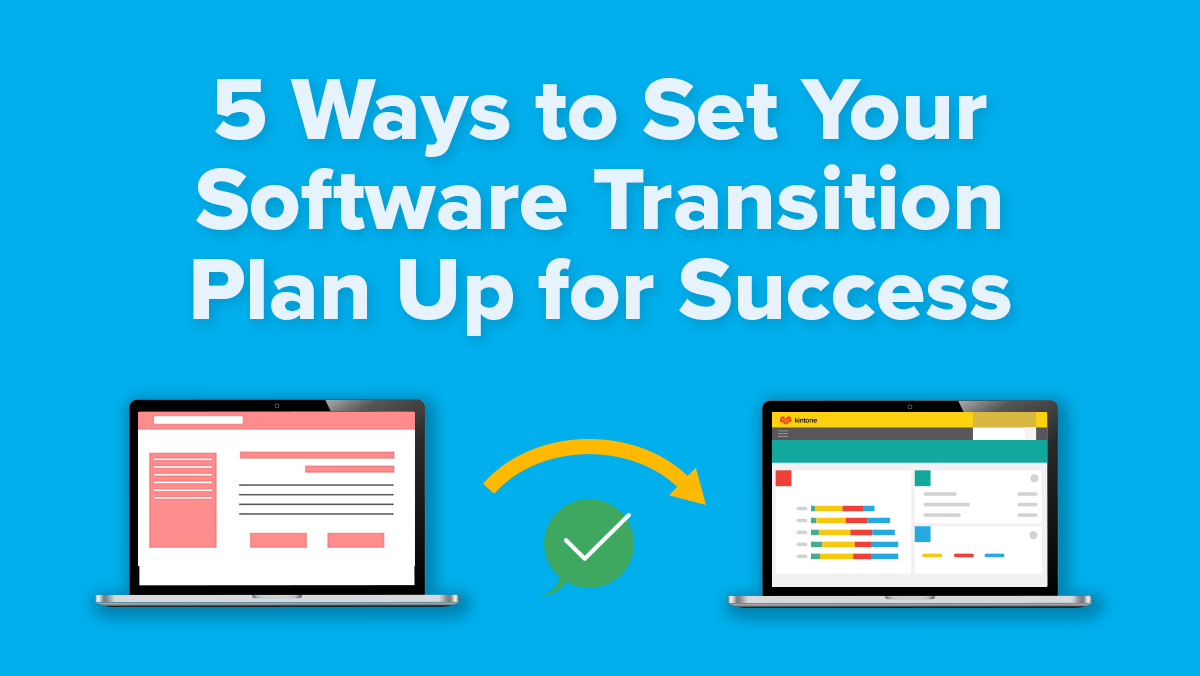There are two types of people in this world: the ones who embrace change, and the ones who run from it. Our team at Kintone loves you either way, but if you’re someone who identifies with the latter, we’re here to help you trade in your running shoes for a nice cozy pair of slippers.
Okay, so maybe that wasn’t our best metaphor. But the point is: we understand change can be scary and stressful, especially when it comes to switching up your software, business processes, and systems. However, there are a few things you can do to set yourself up for a seamless, stress-free, successful software transition – and we’re going to dive into 5 of them in today’s blog post.
1. Identify All Affected Parts of Your Business
One of the first and most important steps you should take in the process of changing business software is to get a grasp on who and what will be affected by this transition. This can include identifying the data, departments, partners, and employees who currently use the software that is being upgraded or replaced.
To do this, you’ll have to know what’s working and what needs to change. Maybe you’ll check in with the marketing team to see how their CRM software has been serving them, or if spreadsheets are limiting the capabilities of your finance department. If those are working, great! If not, it’s an ideal time to see if and how your new software can help.
Whether you’re a small or large company, even the above tasks alone can seem daunting. Creating a checklist of the who and whats, along with what’s working and what’s not, is an easy way to keep yourself organized and visualize the scale of this process.
2. Save Copies of Your Data Before You Begin Migrating It
Although this may sound obvious, we’re going to say it anyway: Backup. Your. Data.
Losing valuable company data is the last thing you want to happen during a software transition. This can lead to plenty of project delays and communication errors, not to mention legal consequences if you lose track of sensitive customer data.
This data doesn’t have to be just spreadsheets and numbers – it can include everything from important emails to company presentations and more. Saving copies of these assets to a separate cloud or drive is essential to a successful transition.
3. Do a Test Run
We know we just encouraged you to trade in your running shoes, but not before a quick test run. Before you commit to making a company-wide change, try experimenting with a small part of your business first.
Testing new software on one area of your business will give you greater insight into what to expect and plan for during your wider transition, as well as bring any bumps in the road to light. Maybe you’ll even discover parts of the process you didn’t plan for, and add extra steps to your timeline as a result.
Once you’ve gone through the process on a smaller scale, you’ll have a better idea of how to manage it on a larger one.
4. Develop a Plan for Team Adoption (and Resistance)
If you’re stressed about change, chances are your team is too. This is especially the case when you’re asking them to change how they’re doing things, in addition to getting their day job done. Their current process is familiar and intuitive, changing that up is uncomfortable and comes with a learning curve.
The first thing you can do to ease employee nerves and stress is to communicate the “why” behind this change. Clearly explain the long-term benefits, the positive impact on their day-to-day, and the bottom-line ROI. And when possible, do this before you even implement changes. Oftentimes, we already know who on our team is going to resist change; use your social knowledge of the team dynamics and get ahead of those feelings before they arise.
By creating a plan to personally address those individuals and their concerns while giving them room to offer their feedback, you’ll make them feel heard, cared for, and understood. Sometimes, all people need to know is that they’re more than a number and that you’re working to meet them halfway.
5. Set Up Timelines and Check-Ins
Lastly, after you’ve thought through all of the above, establish a timeline for the completion of the software rollout.
As with any important project, creating a timeline keeps you organized and prepared while holding you accountable in the process ahead. Setting measurable milestones within your timeline can also help set expectations and give teams an idea of exactly what should be done in the process leading to final completion.
Additionally, incorporating regularly scheduled check-ins along the way can provide the support your employees need to navigate each step of the transition, while also providing an opportunity for them to ask questions and solicit feedback.
In Conclusion
Rollouts might come with bumps along the way, but with preparation and planning you can keep things on track and progressing. Which means a shorter onboarding time and a faster chance at seeing the ROI on your new solution.
About the Author
Michaela is a part-time freelance writer passionate about writing creative copy and content. She graduated with her Bachelor’s Degree in Marketing, minor in Creative Advertising, and has spent time working for start-up companies, agencies, and large enterprises in the marketing and brand strategy spaces. Outside of the office, she’s an avid foodie and traveler living in Chicago, Illinois.











